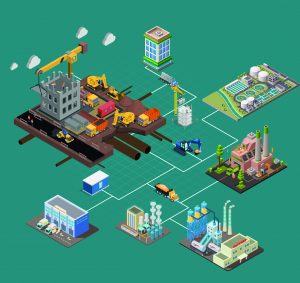Digital continues to disrupt and excite the construction industry in equal measure. The cavalcade of terms and technologies – Big Data, data warehousing, ubiquitous connectivity, artificial intelligence, augmented reality, and so on (and on) – continues unabated, promising increased efficiencies, greater insights and improved service delivery. However, the value of this technology remains only a fraction of what it could be
As Stefan Webb from Future Cities Catapult (now part of the Connect Places Catapult) highlighted in his article for PBC Today, back in 2017, data, especially within cities and infrastructure, remains a largely untapped resource.
The greatest barrier to liberating value is that data and controls are traditionally locked within platforms, systems and siloes. New technologies promising greater flexibility, agility and transformation, are too often isolated from incumbent platforms, systems and databases. The existing siloes of data and controls are unmanageable. Legacy systems which should be a competitive advantage exist in parallel to the new developments rather than informing and complementing them. Traditional IT solutions that present single-vendor solutions are seen as inflexible and expensive. According to a recent survey by the SAP User Group, DSAG, 62% of companies described their progress on Digital Transformation Projects, seen as critical to business, as “Not Far” due to ever-expanding scope and cost.
Are Digital Twins a solution?
As frustrations with the challenge of siloed data and hidden value continues, we have seen the launch of a number of initiatives to tackle the systemic barriers to further development.
The 2017 National infrastructure Commission (NIC) report, “New Technology Study: Data for the public good” looked at the opportunities that innovation enables and how open data sharing can support those opportunities. It made the recommendation that there should be a creation of “a digital twin of Britain’s infrastructure”.
An outcome of that recommendation has been the creation, by the Centre for Digital Built Britain and their partners, of a set of principles behind creating an ecosystem of connected Digital Twins, the Gemini Principles.
Elsewhere we have seen Greater Cambridgeshire Partnership and Telensa announce the creation of a city-wide digital twin, with the aim of designing better city infrastructure, delivering more efficient city services.
Digital Twins individually and federated together are increasingly being seen as a solution to the need for interoperability between data sets, siloes and services, but there remains a lot of confusion as to what a Digital Twin is and, as importantly, what it isn’t!
What is a Digital Twin?
A significant element of the ambiguity around Digital Twins and their value is owing to the emphasis on visualisation rather than virtualisation. In many sectors, Digital Twins have come to be seen as 3D Models, reporting tools and, at their best, constructs for simulation and emulation. They tend to be representations of a specific geography, asset, system, or process: distinct and separate. While many are static, little more than CAD/CAM models, increasingly there have been improved virtualisation visualisations, which use live data alongside historical interoperating platforms and sources. Once again in Cambridge, we’ve seen innovative mapping Start-Up SenSat demonstrate, in collaboration with Mott MacDonald and Safehouse Sensors, what can be achieved with new technology to map visualise and interrelate multiple data sources and sets.
We can however go further. At Iotic, we define a Twin as a comprehensive, interoperable version of anything, all its data, all its controls, through its whole life. The addition of controls, as well as data, is vital. The great power of Digital Twins comes not from what they can show us, but how they can securely and meaningfully interact with each other. The ecosystem of connected Digital Twins highlighted in the Gemini Principles or, as I presented at a TechUK event on this subject earlier in the year, can create not a National Digital Twin but a nation of digital twins.
A real twin is one that can interact, interrelate and behave in a digital environment as its twinned counterpart does in the real world. It is a semantically defined virtual counterpart to anything which can securely interact and be federated together across organisations and supply chains, enabling a single source of truth (we aren’t copying data into platforms, or creating new data lakes), enhanced monitoring, prognostics, new services and solutions that would not otherwise be possible.
By creating Digital Twins of anything and everything – every source and consumer of data and controls – what we are really doing is creating a machine-readable world: a world that can harness the power of Machine Learning, Artificial Intelligence, algorithms, business process rules and security and access control profiles and platforms.
These twins provide security to our vital assets and infrastructure not only through the insight information and management they enable but through their very existence. Twins are by their very definition not the thing itself. This abstraction from the real to the virtual digital space, enables interoperability between twins, brokered interactions between sources and consumers of data across companies, buildings, supply chains and the wider world without the need to provide direct access to any of the ‘real’ asset platforms, processes or systems.
There remains of course a role for representations and renders of interoperable twins. 3D models can be powerful tools presenting insights and helping partners to see opportunities to collaborate, highlight bottlenecks and enable others to visualise assets, systems and whole processes powerfully.
But they are just one manifestation of a twin: a view of the data and controls that a twin has. In our experience, different users, organisations within a supply chain and stakeholders can, and will increasingly, have their own visualisation, dashboards, and models of the same twins, interacting with what is important to them and interoperating with the other twins in their world. A Site Manager may want a twin of an individual construction site, showing live deliveries. Meanwhile, an Area Manager may want to assess the performance of equipment across sites, making his or her twins the individual pieces of equipment.
From disruptor to disrupted
As organisations start to adopt real Digital Twins, they are liberated from viewing data and controls based on technology, which is traditionally a view of the world determined by an organisation’s internal processes, databases, tech providers and siloes of information. Instead, they can take the perspective of a customer’s view of the world, federating twins around what matters to them – their site, building, office, city, network, service agreement or entire organisation.
Redefining around what matters to you, or more pertinently to customers or stakeholders, additionally creates the flexibility to adopt new technologies and approaches while maintaining downstream services, leveraging existing process, and benefiting from technologies that have previously been confined to proof of concept or innovation activities.
Adoption and transformation is coming: BAM Nuttall, the civil engineering contractor, has been working with Iotic to start creating twins of its assets, supply chain, and partner information by interrelating point solutions, third-party information and innovation programs and develop an interoperable ecosystem that delivers benefits within projects, across organisations and to their partners and stakeholders.
Conclusion
The power of Digital Twins is in their ability to interact meaningfully with each other and to create ecosystems where data and controls from anything, owned by anyone, can safely interoperate. The ecosystems will grow and evolve over time, powering multiple use cases, solutions and services, and working across technology providers and legacy systems. With real Digital Twins, we can start anywhere and grow exponentially, flexibly evolving the federated and composite twins of what we need now and what we will need in the future, adapting to new technology and changing requirements, and delivering outcomes we cannot yet even envisage.
Ali Nicholl
Head of communication
Iotic
LinkedIn: Iotic-labs
Twitter: @ioticlabs














